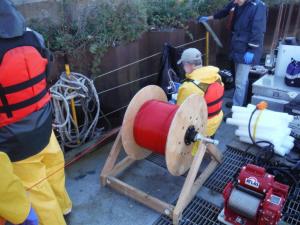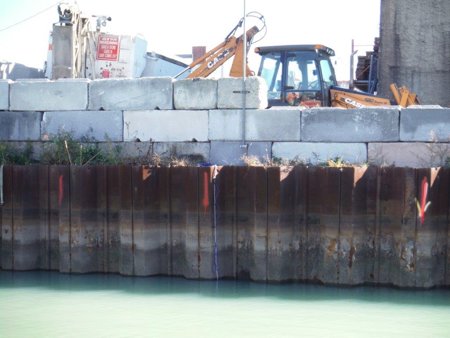The Design Team and its contractors are engaged in several activities on the canal. These activities are part of our ongoing effort to further study the canal and develop the remedial design. Information gained from these studies will help the United States Environmental Protection Agency (EPA) and the Design Team develop and implement a lasting remedy for the canal
Canal Sediment Study (Bathymetric Survey): This month we continued our study of the canal’s Bathymetry, which measures and analyzes its floor. This study began in October 2014 and requires multiple surveys. By doing multiple surveys, we can see how the canal bottom changes over time.
The most recent survey allows us to see how the canal bottom has changed since the New York City Department of Environmental Protection (DEP) activated of the Gowanus Canal Flushing Tunnel in December 2014. As water flows into the canal from the Flushing tunnel, Sediment may move and shift, altering the bottom of the canal. More generally, information gained from the series of bathymetric surveys will be helpful for the site remedy, particularly in designing a cap for the bottom of the canal. Groundwater Studies: In November 2014, we installed several pieces of equipment into the canal to provide information that will allow us to better identify the locations where groundwater discharges into the canal.
This equipment included:
Fiber Optic Cables: We installed a network of fiber optic cables that stretch from north of Carroll Street to north of Degraw Street (approximately 1,000 feet). The cables continuously measure the temperature of water within the sediment beneath the canal floor. The technology relies on the fact that groundwater temperatures remain nearly constant year round. During winter, the groundwater will be relatively warmer than the canal water. Therefore, areas of warm water identify areas where groundwater may be entering the canal.
Automated Sensors: Automated sensors, or vibrating wire piezometers, were installed in pairs at different depths in the canal floor. The sensors will help us determine the amount of groundwater being discharged into the canal. The sensors do this by monitoring hydraulic pressure beneath the canal.
Water Level Sensors: We installed an automated sensor off of a Bulkhead near Nevins Street. The sensor continuously records canal water levels and temperature. Data collected at this location will provide valuable information that we will use for many elements of the remedial design investigation.

The Design Team conducts survey work on the canal.

The team works on installing the fiber optic cables for groundwater studies.

Sensors are carefully placed and secured in the canal to gather information for developing the remedial design.Non-Aqueous Phase Liquid (NAPL). On-site work for both of these projects will occur on or near the former Citizens former Manufactured Gas Plant site. In addition, the National Grid will continue contacting property owners along the canal to request access to their property. If you have any questions in the meantime, please contact us.
